For those who aren’t familiar with HubSpot, they have a powerful CRM offering but they’re also leaders in digital marketing education. You’ll find that their blogs and guides often come up when you’re searching the digital marketing space – talk about good SEO, am I right? But we’ve also found their free courses and certifications – all taught by industry experts – really helpful as well to introduce new team members to our world as well as to brush up our own skills as they update their content.
So that’s why it was pretty exciting when Woj, Oscar, Greg and I got the chance to head to Sydney to see it all in action at the GROW with HubSpot conference last year. It was a great opportunity to hear from CMOs, marketing managers and key team members from some exciting brands as well as HubSpot themselves share their knowledge and industry tips.
Below, we share some of our key takeaways from the day.
- Building teams: Speed is a learned skill
- Google Ads: Align content with search intent
- Innovative leadership: Digital disruption and staying ahead of the curve
- Beating the algorithm: strategies to get your videos out there
Building teams: Time is a fixed resource, speed is a learned skill
Greg, our Operations Manager – or Business Ops Guy as he prefers to be known – is all about finding ways to help grow Kwasi and make our team more efficient. So the leadership and team building sessions at GROW were right down his alley. There was a lot of useful advice, philosophy and thought provocation but he’s narrowed it down to two actionable takeaways that were relevant to the Kwasi team’s – or any team’s – improvement, and that can be easily adapted.
Walk the Talk: Becoming an Innovative Leader in a Digital Age
Stephen Scheeler, CEBIT Australia, The Digital CEO and Former Facebook CEO for ANZ
Greg: Stephen gave a great presentation on the importance of being an innovative leader, drawing from his successful leadership experience. There were many great points that I took on board however, the main actionable takeaway I got from this is that time is a fixed resource, speed is a learned skill.
At Kwasi, we’ve been focusing on training and developing our team members to make sure that they are fully equipped not only to do their job but to do their job well – and efficiently. Stephen highlighted some points that I want to share here:
- Focus on impact
- Most meetings are a waste of time for people involved – so meetings should only be scheduled to:|
– Tell
– Ask
– Decide
– Brainstorm
To build on the point above, people attending meetings isn’t a given. Make the person who has set the meeting earn your attendance. Make them earn your time.
Also, ask the following questions:
- Do you need to be there?
- Are you adding to the meeting?
Just because you get invited doesn’t mean you should accept. In fact, unless you have a clear role to play in the meeting you are encouraged to decline.
A Model for Success: Atlassians Research on Building High Performing Teams
Jamie McCollough – Head of Performance Development, Atlassian
With Confluence and JIRA under their belt, it’s safe to say that Atlassian know a thing or two about team collaboration and issue tracking. So it was very interesting to hear their thoughts on teamwork and see the real research they have undertaken on factors that drive high performance in teams.
Although the research is ongoing, they have established eight measurable attributes assist the team in performing at increasingly high levels. They are in no particular order.
- Team Balance
- Team Cohesiveness – experiences are shared and there is trust and respect across the group
- Shared Understanding
- Defined Value & Metrics
- Decision Making
- One Pager – Standing behind the collective Vision and Value
- Managed Dependencies – Ask the question: are we easy to do business with?
- Velocity – Do we get shit done?!
While I have a bit more reading to do, these attributes and implemental tools seem like a great guide to getting the most out of the team without eating into too much time. I look forward to being able to adapt them into Kwasi operations after due diligence.
Align content with intent: give the people what they (actually) want
Oscar is currently our longest standing team member, and during his time at Kwasi, he’s dipped his toes into many digital marketing pools. However, we’d definitely say he’s our keyword research expert and PPC lead. In his day to day role, he has to make sure that whatever we’re producing for clients – whether it’s an ad or pages for a website – matches the user’s initial search intent. In case you didn’t know, Google places a lot of value (and trust signals) in content that actually aligns with what the user is searching for. So if you get this right, it means a nice boost in hard-earned SEO efforts as well as things like better scores in Google ads. Hubspot’s own Matthew Barby spoke about this very content alignment issue, which is probably why Oscar picked this session.
Doing More With Less
Matthew Barby, Director of Acquisition Marketing at HubSpot, previously Global Head of Growth and SEO.
Oscar: Matthew Barby’s talk really brought to light just how much the Google juggernaut constantly strives to create a more intelligent and adaptable search engine for all users.
I’ll summarise his talk using the search term “liverpool fc” – he actually used Manchester United but I couldn’t bring myself to do the same – Matthew demonstrated how Google will continually evolve its search results by predicting user intent based on the time of the week the search takes place.
If you search for ‘liverpool fc’ during a match day and you will be given live scores of the current game. After the weekend Google’s SERPs will adjust to show you the teams latest result, understanding that the user intent has now shifted.
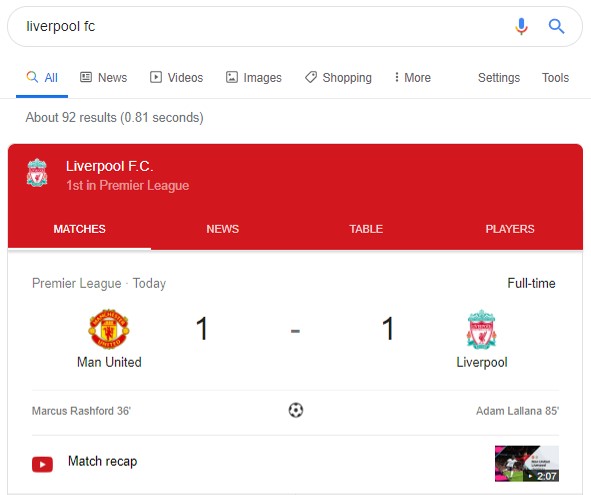
Search the same term mid-week and Google SERPs will change to show you team news as well as upcoming fixtures.
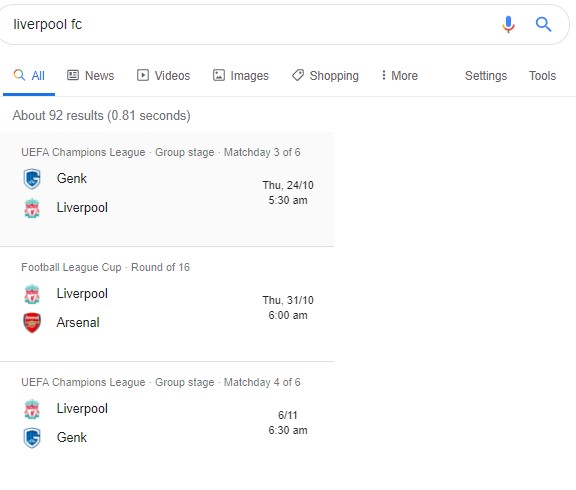
While this is a simple point which most of us probably take for granted in today’s search experience, it is a clear demonstration of how far Google has come in adjusting its algorithm to ensure it is always aligned with user intent.
Barby points out that Google’s advanced way of thinking makes it critical for SEOs and content creators to become hyper-sensitive when it comes to aligning content with the precise intent behind the search query.
He then offered a few SEO tips and tricks on how we can go about adjusting our strategies to squeeze the most out of search:
- Favour precise content over broad content.
An article tackling the topic of “best time to post on Instagram in 2019” is going to win out over a broad content piece such as “best time to post on Instagram, Facebook and LinkedIn”. - Long form is not always the way to go.
Short and concise articles which get to the point quickly can often win out depending on the search query. - Utilising quick and direct answers gives you the opportunity to appear in snippets and other SERP features.
- Develop topic clusters and content hubs to build out your sites authority and expertise in that niche.
For example, couple your ‘best time to post on Instagram in 2019’ article with other posts on ‘best software for photo editing’, ‘how to create the perfect Instagram theme’ and ‘creating a content schedule for your Instagram’. - Check the second tab of search results.
This will give you as big clue as to the intent behind the keyword and what content Google is delivering.



When I’m training others on keyword research at Kwasi HQ, I often find myself encouraging others to treat Google as a user intent cheat sheet.
For me it’s always really cool to get an insight into how some of the top guys in the field are executing similar SEO strategies to achieve their success.
Innovative leadership: Digital disruption & staying ahead of the curve
Being the head honcho at Kwasi, it’s understandable that this talk on innovative leadership was Woj’s highlight from this conference. While Greg also highlighted Stephen’s talk, Woj has some different takeaways. He’s really honed in on how a business has to stay ahead of the curve in order to thrive. The specific example is about Facebook – Stephen was the former ANZ CEO for the social media giant – and the ultimate buzz word, disruption, and how they’ve tackled in order to stay relevant. The same applies to digital marketing – an ever-growing industry where we all have to keep learning to make sure that we stay masters in our field.
Walk the Talk: Becoming an Innovative Leader in a Digital Age
CEBIT Australia, The Digital CEO and Former Facebook CEO for ANZ
Woj: My favourite talk was by Stephen Scheeler who helped grow Facebook in Australia, and which centred around disruption. Customers are very quick to take up technology in Australia and Facebook was pretty much number one on all metrics that mattered internally to the global business so it was a great test market.
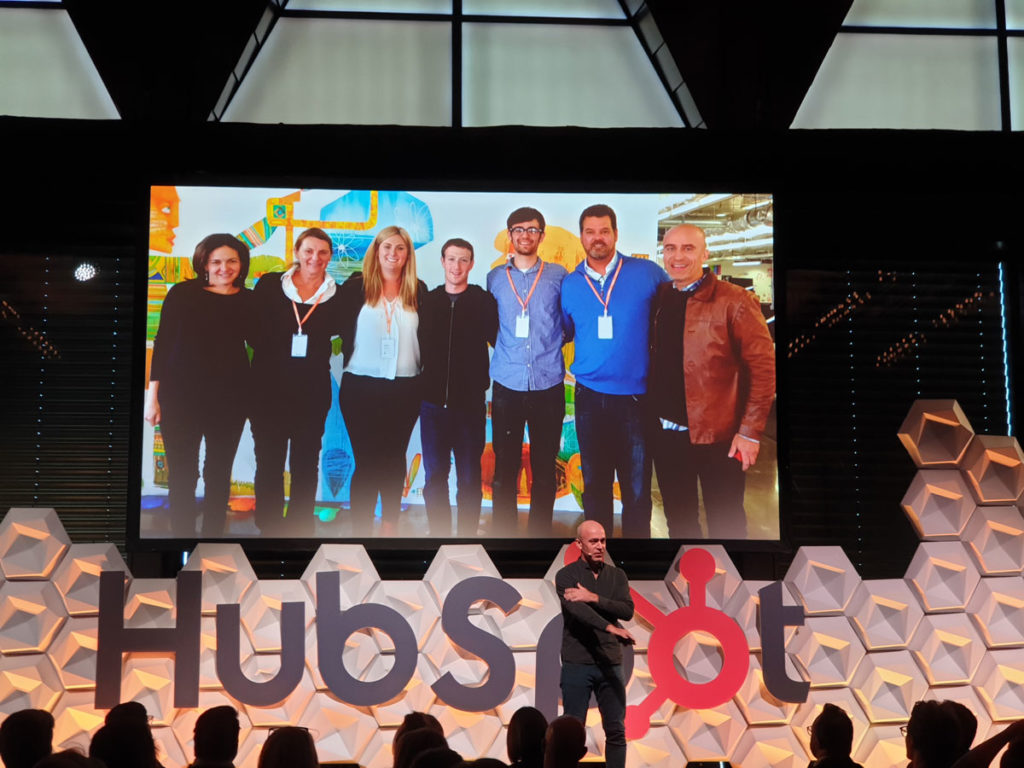
He told a story about the speed of disruption – specifically about their acquisition of Instagram. He mentioned that due to Facebook’s insatiable hunger to make sense of data, they identified that the mobile engagement rates on this one particular app were sky-high and skewed to a particularly young demographic. The app was a mobile-only business about sharing photos from one phone to another whilst Facebook was solely desktop-focused.
Facebook founder, Mark Zuckerberg, said they needed to get to know this app a little more as they were seeing this disruptive tsunami coming at them so he met the founder. He eventually got to know Kevin Systrom after visiting his café several times – he was a barista at the time because everyone in Silicon Valley has a second job while they’re running their startup! And a year later, Facebook acquired Instagram for $500 million.
“And so Instagram was a moment in time when, you know, Facebook saw this disruption coming and managed to get ahead of it,” Scheeler explained. “And luckily, we did it, because if you look at the trend, obviously, it happened… It seems like sharing photos on your phone, like, ‘Wow, no shit, Sherlock. It’s a big thing,’ right? Well, back in 2010 it was known as a big thing. It was a new behaviour, it was a new technology, and it was being driven by a new consumer. This was all new stuff even to Facebook.”
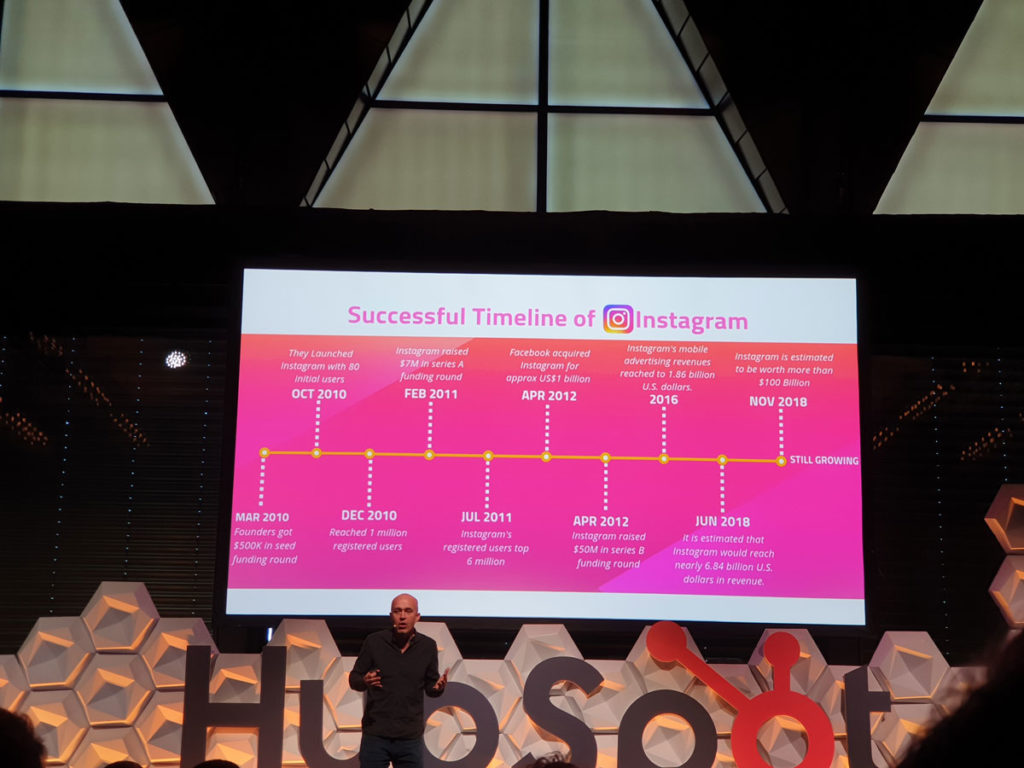
Some people have said that it’s one of the most valuable acquisitions – if not, the most valuable – in history! So look for those insights beyond the vanity metrics and dig deep into the data.
Another interesting point Scheeler made was around being able to get ahead of the disruption before it takes over so you can plan and pivot adequately. Facebook had to pivot to mobile rapidly. He made the following analogy.
“So you need to find ways for business to get out to the ocean and be a ship on the ocean. If a tsunami passes under you when you’re on the ocean, what happens? You just get a little bump. It goes underneath you. And so finding ways to get out into the ocean to make sure you see the disruptions coming and you’re quick to act is more important than ever. And whole businesses and industries are now being wiped out because they’re standing on the beach waiting for the wave to come in.”
So get on the front foot and make bold observations. What are other industries doing? For example, why isn’t there an Afterpay for business so clients pay us on time?
Facebook runs thousands of experiments a day every day. They learned to look for that faint signal. You can’t wait until you have all the data.
“Acting early on faint signals amongst the noise is really, really important… and experimenting” Scheeler added.
We need to hustle – move fast, break things and clean up later. Make sure you are constantly experimenting, learning from those tests and always improving.
Facebook has been disrupted many times and experienced some major moments due to mobile, AI and machine learning (changing their reverse chronological bulletin board to an algorithm-based curated feed), messaging, video and currently privacy and regulation.
And you can already see the next one’s coming: virtual reality, augmented reality, blockchain, human-machine interface, reading your minds, etc.
“Incrementality is probably a recipe for disaster in the sort of modern disruptive world. Move fast, kinda goes without saying. Be bold!” Scheeler asserted.
Also, being paranoid isn’t always a negative thing. It’s not just about data and science. It’s about the emotion of paranoia and obsession.
If you go to Silicon Valley and you visit Apple, Google, Facebook, and you get your photo taken in front of the sign…
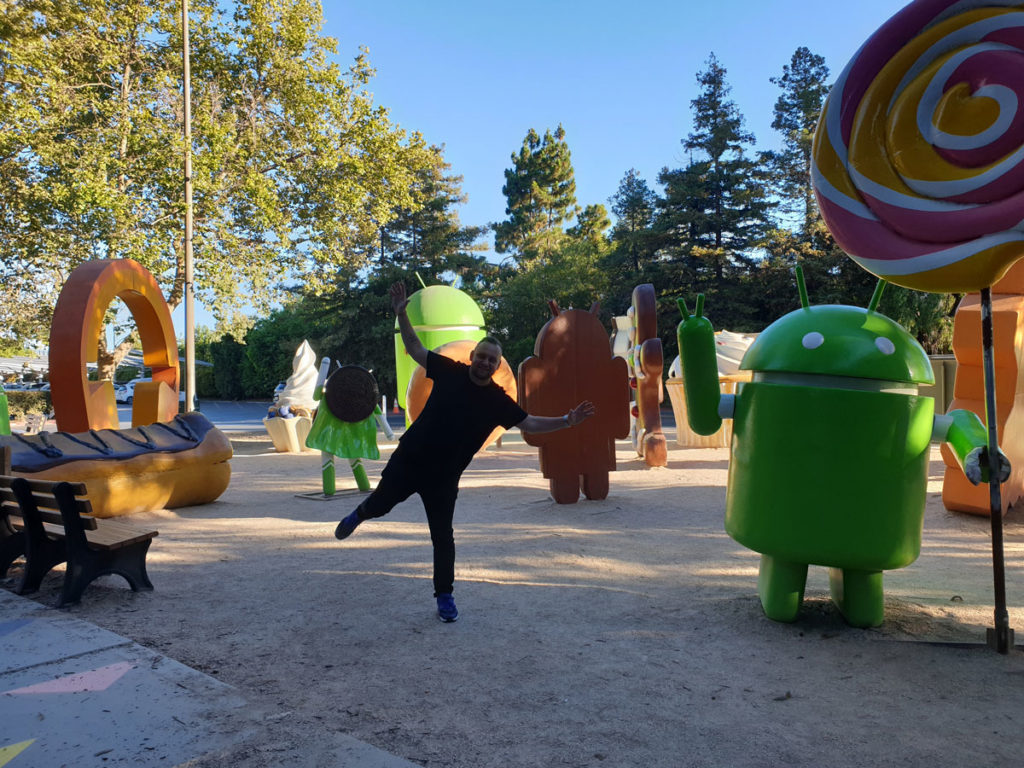
“If you go to Facebook and you pull over, get out of your car, get your picture taken in front of the sign, before you get in the car and drive away, walk around behind the sign because most people don’t. And this is what you’ll see,”

“All 19 buildings that Facebook moved into was the old Sun Microsystems campus – the biggest company in Silicon in the 1990s. [It was] a two hundred billion-dollar giant, the biggest IPO in history – they were the Google and Facebook of their time,” Scheeler explained
“[But] by 2006, Sun was gone. They were acquired by their arch-rival Oracle for pennies on the dollar. They disappeared. They essentially missed the pivot from hardware to software. So Facebook, when we moved in, Mark said, “Don’t get rid of the sign. Just turn it around.” So when you sit inside Facebook and you look out the window, you see the Sun Microsystems sign. It gives you a little sense of paranoia that there was another great company here once that is now no more.”
So a little reminder of what happened to companies of the past is a good way to keep you motivated to keep ahead of the curve.
Don’t become a Kodak – or have to close your bricks and mortar stores because “we have done things this way for years and it worked”. Keep an eye out for the next disruption in your industry, dig into the data and look for things that aren’t obvious, run experiments and kick more digital goals!
Getting your content served: Can you really beat the algorithm?
Ah, the elusive a-word that’s ruined every social media practitioner’s livelihood over the last few years. My day-to-day job at Kwasi orbits around creative content – so paid and organic social media strategies and execution, written content, marketing automation and how that all ties together. While I love every aspect of it, the social media part is what gets me going – and partly because it’s always keeping us on our toes. Referring back to Woj’s section above where Stephen talks about how Facebook has had to face multiple disruptions and keep innovating to stay ahead, we’ve consequently seen the social media platform landscape so much. So it was interesting to see what someone from Shootsta, a video production studio, could tell me about getting my videos served.
How to stand out with video on social media
Melissa De Coster, Client Services Manager at Shootsta
Tammy: I think by now, everyone knows that video content is the most engaging. Whether you’re on Facebook, Instagram, or especially the latest social media phenomenon, TikTok, you’ll stop and watch a video at some point everyday. Melissa started her talk off with some seriously impressive numbers – a CISCO stat that said by 2022, 82% of all consumers internet traffic will be video. So we better pay attention to it right? Both as a brand and as marketers for our clients.
But what often gets overlooked as consumers is how hard it is to get your videos served to the right people, especially organically. So the two key challenges that this talk was going to deal were:
- How to get your video served?
- How to beat the algorithm
- How to get your video watched?
In relation to the first challenge of getting your video served, we were to have to look at the serving mechanisms (algorithms and AI) then take a deep dive into the algorithm’s favourite data – views, average view duration and engagement.
Melissa presented three strategies to give your videos the best chance:
- Native Content Strategy (interaction)
Here she offered a simple solution: post the video directly onto the platform, whether it be Facebook, Instagram or whatever you’re using. - Pull Strategy (search)
Being digital marketers, this tip was familiar. You have to ensure that all your content, even video is fully SEO-optimised. Make sure simple things like the title and captions reflect what is in your video. When there are categorisation options, ensure that your video falls into the right field. This will help when someone searches for a video that matches the intent of your video, and it will be served as an option. - Push Strategy (feed)
This one is probably already familiar to those who work in social media – it’s to take a deep dive into analytics and use these insights to see when your audience is the most active and engaged in order to figure out when to serve a video to them. She also mentioned that we shouldn’t be afraid to boost a post – but let it perform organically first then make your (paid) move.
To deal with the second challenge she put forward – how to get your video watched – the answer was straightforward create a meaningful video that will pique your target audience’s interests. We all know our audiences so well – a well-researched digital persona helps too – so really, creating content that engages them should be easy, right?
What was interesting in this second part was her presentation of ‘The Watch Journey’ – so essentially, the journey that the consumer goes on when they start a video, and ultimately whether they choose to stay engaged with it.
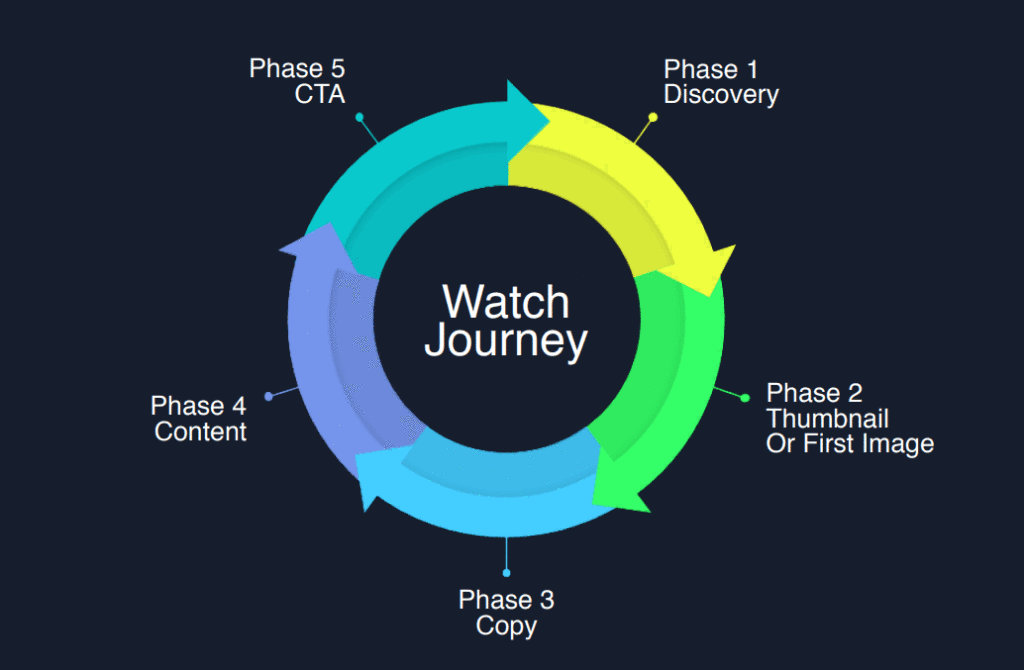
Phase 1: Discovery
So this is the very first part where they initially find the video either via search or appearance in the feed. This is also where those three strategies that Melissa presented earlier will help (native content, pull and push)
Phase 2: Thumbnail
Beyond the first phase though, things like the thumbnail or cover image are also really important. Think about when you’ve seen a thumbnail image. What has inspired you to stop scrolling and keep watching? Also, have you noticed that on mobile, a Facebook video doesn’t automatically start playing when you scroll past it? You better make sure that thumbnail image is engaging!
A good thumbnail, Melissa suggests, will have primary colours and beautiful images – think people, animals and food. And when it comes to fonts, stick to neutral, large and easy to read fonts.
Phase 3: Copy
If you’re already serving a video, don’t also try to bombard your viewer with text. Short, sharp and simple copy should help the user dettermine usefulness (what this video is about), desirability (who is video for) and usability (is this what I expected to see).
So Melissa suggests, to the point copy that compliments both the thumbnail and the content. Try things like questions that require clicking for an answer of numbers – you know those Top 5 or Top 10 lists that you can’t help but engage with – Buzzfeed, we see you. Superlatives are also great because nobody is interested in second best.
Phase 4: Content
As for the content itself, Melissa says that Shootsta goes by the 3/10/30 rule.
- By 3 seconds: grab attention (with a question or a superlative)
- By 10 seconds: set the scene (what exactly is this video going to be about?)
- By 30 seconds: get your core message across (what is the point of the video?)
Generally speaking, and you probably see this as a viewer yourself, if you haven’t done these things by this time, people will start dropping off. That in itself serves as a signal that your video isn’t very engaging and isn’t worth serving.
Phase 5: CTA
At the end, don’t forget to add a CTA. By this time, the viewer has watched your whole video so restart the cycle with a strong call to do something. Whether it’s click through to the website for more information or buy this product now. BUT keep in mind decision fatigue when doing this as well. Don’t be too pushy.
In general, it was a nice reminder that we already have so many of the tools to get our videos served and watched. With so much going on, whether our a brand or a marketer, we often forget this. I’ve personally been quite inspired by using all my existing skills to help strategise engaging video content for our clients. And I hope, if you’re reading this, that it will help you recognise your own skills in this area too.
Now put these tips to use!
With such a diverse range of topics covered on the day, we hope we’ve rounded up some useful tricks from across the digital marketing fields that can be applied to your own digital marketing strategies. Stay tuned to the blog as we bring you more useful round ups from the industry events that we’re heading to this year as well as our own original content.
